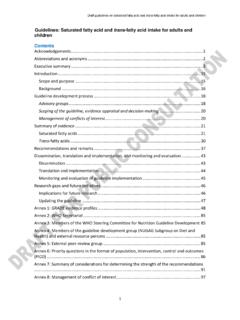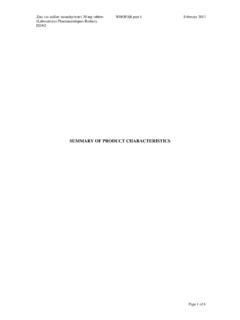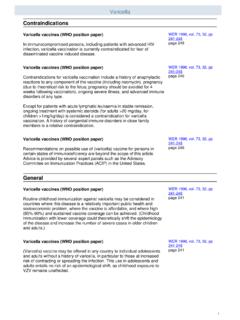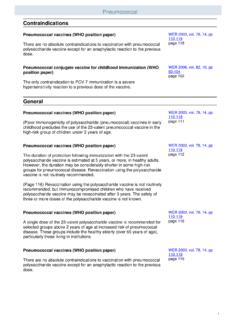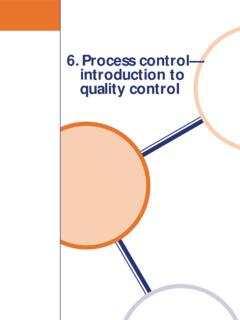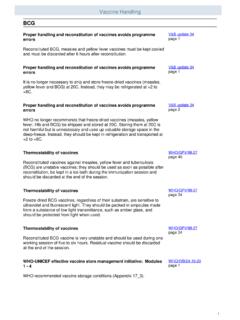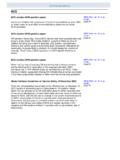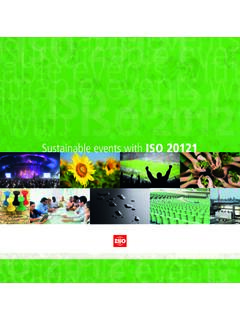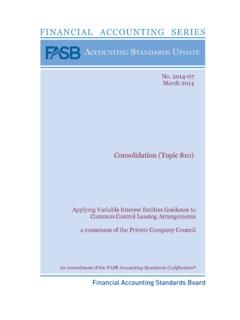Transcription of Active Ageing - World Health Organization
1 Active Ageing : A P O L ICY FRAMEWORKWHO/NMH/ : GENERALORIG.: ENGLISHA ctive AgeingA Policy FrameworkWorld Health OrganizationNoncommunicable Diseases and Mental Health ClusterNoncommunicable Disease Prevention and Health Promotion Department Ageing and Life CoursePA G E 2 This Policy Framework is intended to inform discussion and the formulation of action plans that promote healthy and Active Ageing . It was developed by WHO s Ageing and Life Course Programme as a contribution to the Second United Nations World Assembly on Ageing , held in April 2002, in Madrid, Spain. The preliminary version, published in 2001 entitled Health and Ageing : A Discussion Paper, was translated into French and Spanish and widely circulated for feedback throughout 2001 (including at special workshops held in Brazil, Canada, the Netherlands, Spain and the United Kingdom).
2 In January 2002, an expert group meeting was convened at the WHO Centre for Health Development (WKC) in Kobe, Japan, with 29 participants from 21 countries. De-tailed comments and recommendations from this meeting, as well as those received through the previous consultation process, were com-piled to complete this fi nal complementary monograph entitled Active Ageing : From Evidence to Action is being prepared in collaboration with the Inter-national Association of Gerontology (IAG) and will be available at where more information about Ageing from a life course perspective is also provided. A contribution of the World Health Organization to theSecond United Nations World Assembly on Ageing ,Madrid, Spain, April G E 3 Active Ageing : A P O L ICY FRAMEWORKC ontentsIntroduction 51.
3 Global Ageing : A Triumph and a Challenge 6 The Demographic Revolution 6 Rapid Population Ageing in Developing Countries 92. Active Ageing : The Concept and Rationale 12 What is Active Ageing ? 12A Life Course Approach to Active Ageing 14 Active Ageing Policies and Programmes 163.
4 The Determinants of Active Ageing : Understanding the Evidence 19 Cross-Cutting Determinants: Culture and Gender 20 Determinants Related to Health and Social Service Systems 21 Behavioural Determinants 22 Determinants Related to Personal Factors 26 Determinants Related to the Physical Environment 27 Determinants Related to the Social Environment 28 Economic Determinants 304.
5 Challenges of an Ageing Population 33 Challenge 1: The Double Burden of Disease 33 Challenge 2: Increased Risk of Disability 34 Challenge 3: Providing Care for Ageing Populations 37 Challenge 4: The Feminization of Ageing 39 Challenge 5: Ethics and Inequities 40 Challenge 6: The Economics of an Ageing Population 42 Challenge 7: Forging a New Paradigm 435.
6 The Policy Response 45 Intersectoral Action 46 Key Policy Proposals 461. Health 472. Participation 513. Security 52 WHO and Ageing 54 International Collaboration 55 Conclusion 556.
7 References 57PA G E 4 This booklet uses the United Nations standard of age 60 to describe older people. This may seem young in the developed World and in those developing countries where major gains in life expectancy have already occurred. However, whatever age is used within different con-texts, it is important to acknowledge that chronological age is not a precise marker for the changes that accompany Ageing . There are dramatic variations in Health status, participation and levels of independence among older people of the same age. Decision-makers need to take this into account when designing policies and programmes for their older populations. Enacting broad social policies based on chronological age alone can be discriminatory and counterproductive to well being in older Old is Older?
8 The hands you see in the background design of this paper are celebrating the worldwide triumph of population Ageing . If you fan the pages quickly, you will see them applauding the important contribution that older people make to our societies, as well as the critical gains in public Health and standards of living that have allowed people to live longer in almost all parts of the text and the preliminary version of the paper were drafted by Peggy Edwards, a Health Canada consultant based for six months at WHO, under the guidance of WHO s Ageing and Life Course Programme. The support from Health Canada at all phases of the project is gratefully acknowledged. PA G E 5 Active Ageing : A P O L ICY FRAMEWORKI ntroductionPopulation Ageing raises many fundamental questions for policy-makers. How do we help people remain independent and Active as they age?
9 How can we strengthen Health promo-tion and prevention policies, especially those directed to older people? As people are living longer, how can the quality of life in old age be improved? Will large numbers of older people bankrupt our Health care and social security systems? How do we best balance the role of the family and the state when it comes to caring for people who need assistance, as they grow older? How do we acknowledge and support the major role that people play as they age in caring for others? This paper is designed to address these ques-tions and other concerns about population Ageing . It targets government decision-mak-ers at all levels, the nongovernmental sec-tor and the private sector, all of whom are responsible for the formulation of policies and programmes on Ageing . It approaches Health from a broad perspective and acknowledges the fact that Health can only be created and sustained through the participation of multiple sectors.
10 It suggests that Health providers and professionals must take a lead if we are to achieve the goal that healthy older persons re-main a resource to their families, communities and economies, as stated in the WHO Brasilia Declaration on Ageing and Health in 1996. Part 1 describes the rapid worldwide growth of the population over age 60, espe-cially in developing countries. Part 2 explores the concept and rationale for Active Ageing as a goal for policy and programme formulation. Part 3 summarizes the evidence about the factors that determine whether or not individuals and populations will enjoy a positive quality of life as they age. Part 4 discusses seven key challenges as-sociated with an Ageing population for gov-ernments, the nongovernmental , academic and private sectors. Part 5 provides a policy framework for Active Ageing and concrete suggestions for key policy proposals.
